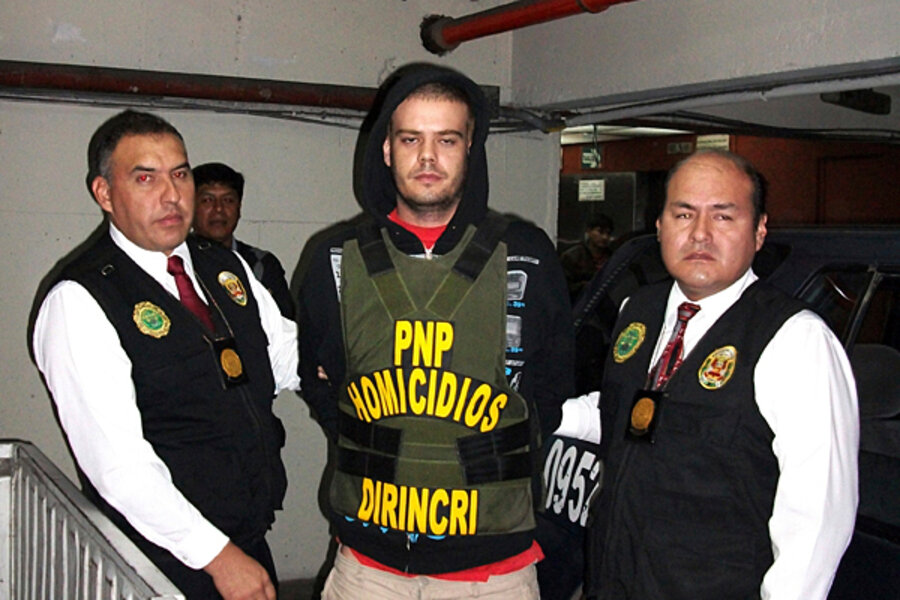Joran van der Sloot murder trial in Peru postponed
| Lima, Peru
This story has been updated at 1:32 pm ET.
Joran van der Sloot, a Dutch national accused of killing a young Peruvian woman in May 2010 and a US teen five years earlier, told judges Friday he needed more time to decide how to plead in the murder trial against him in Peru, which was intended to open today.
Mr. van der Sloot admitted in a videotape made public last September by the Peruvian police that he killed 21-year-old Stephanie Flores in Lima in the early hours of May 30, 2010. The two had met the previous night at a local casino, where van der Sloot was competing in a poker tournament. They returned to his hotel room, where they fought. The police report showed that there had been a violent struggle.
But today van der Sloot said, "I want to give a sincere confession, but I don't agree with all the charges that [have been] placed on me by the prosecutor. Can I have more time to think about this?"
Judge Victoria Montoya accepted the request for postponement. The trial is expected to resume on Jan. 11.
The day after Flores was murdered, 2010, van der Sloot fled to neighboring Chile, 650 miles to the south. He was detained in Chile on June 5 and was immediately expelled then escorted back to Peru for arrest and interrogation.
Flores’s murder happened five years to the day that Alabama teen Natalee Holloway disappeared in Aruba, where she was vacationing. Van der Sloot became the prime suspect in that case, but though he was detained twice in relation to Ms. Holloway's disappearance, he was released both times and charges were never filed because Holloway’s remains were never located.
[ Video is no longer available. ]
Parole possibility?
The eventual trial could drag on for months, given the evidence in the Flores murder as well as the circumstance surrounding the Holloway case. While the trial is technically about van der Sloot's culpability, the real issue appears to be how long he will spend in prison.
The state prosecutor’s office is asking for van der Sloot to be found guilty of first-degree murder that was premeditated and “cruelly and ferociously” carried out. The maximum sentence is 30 years, but there is the possibility of parole. The prosecutor originally asked that the charge be aggravated robbery followed by murder, which carries a life sentence without parole. The court rejected that option in November.
Peru’s legal system does allow for the defense or prosecution to request a change in the charges once the trial gets under way.
Defense strategy
Van der Sloot's defense attorney, José Luis Jiménez, said prior to the trial that while there is no disputing the murder charge, he will fight for the aggravating circumstances to be dropped.
“Our job is to show that this was a tragic event that my client did not intend to happen. It was not done out of cruelty and certainly was not premeditated. No one makes the kinds of clumsy mistakes my client made if they had planned a murder,” he said on Thursday outside a Lima courtroom.
If Mr. Jiménez successfully convinces the three-judge panel, van der Sloot could be convicted of manslaughter, which carries a sentence of seven to 20 years.
“He would likely get the maximum sentence, but the law allows for parole after one-third of the sentence is served,” said Jimenez, who took over the case last June after meeting van der Sloot in prison.
Under this scenario, Jiménez said van de Sloot could technically be out of prison in 2017.
Focus on the escape
The defense and prosecution will be using the same information to prove different points.
While Jiménez maintains that the autopsy on Flores only shows that she and van der Sloot fought, the prosecution will focus on the wording of the report. It states that Flores’s skull was fractured and that she suffered significant blows to the face. There was also evidence of asphyxiation.
The prosecution will also focus on van der Sloot’s escape to Chile and attempt to avoid being returned to Peru. He is currently suing the Chilean government for the expulsion, arguing that he legally entered the country and under international law should have faced an extradition process and not summary deportation.
Jiménez sees things differently. Flores’ body was not found until two days after the murder, which he said would have given van der Sloot ample time to flee Peru if the murder had been premeditated. Instead he hailed a taxi – the taxi driver is also on trial for helping van der Sloot escape – and paid to be driven to the border. Investigators who examined his computer turned up Web searches about Dutch nationals entering Chile and the country’s criminal and extradition policies.
“If Joran had planned this murder, as the prosecution claims, he would have planned a getaway. He did not,” said Jiménez.
While not admitting it, Jiménez’s biggest challenge may be van der Sloot’s notoriety and trying to keep the Holloway trial from creeping into the courtroom.
The trial was set to be conducted in a special courtroom in Lima’s largest prison, Lurigancho. It is close to the maximum-security facility where van der Sloot has been held in relative seclusion for the past 18 months.





